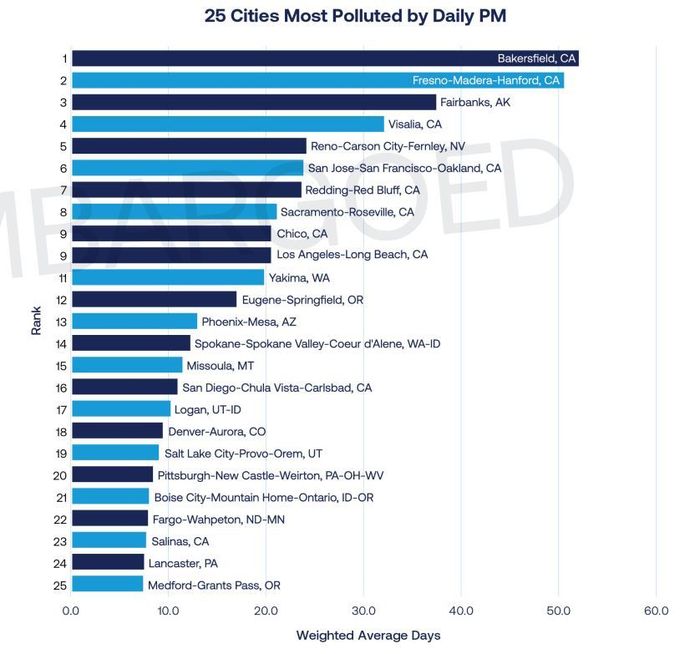A long-established report card grading air quality around the country has uncovered worrisome takeaways. For one, the American Lung Association, which issues the grades, finds that lung cancer among non-smokers is on the rise, with pollution considered a likely contributor.
Second, communities of color are disproportionately exposed to unhealthy air and the serious pulmonary conditions and other medical concerns that come with it.
And third, severe wildfires in recent years made outdoor life in the scenic U.S. West, where population is on the rise, increasingly difficult and dangerous. The lowest grades for air quality cropped up largely in western states.
In all, nearly four in 10 Americans —119.6 million people — live in places with failing grades for unhealthy levels of ozone pollution and both short-term and longer-lasting particle pollution, the American Lung Association said in its latest “State of the Air” report.
The Lung Association has issued the report for 24 years, grading American cities and counties based on the population’s exposure to unhealthy levels of ground-level ozone air pollution, annual particle pollution, and short-term spikes in particle pollution. This year’s report covers 2019-2021.
Dr. Panagis Galiatsatos, a pulmonologist who is the national spokesperson for the American Lung Association, told MarketWatch that he was most unsettled by the latest report’s evidence of the rise in non-smoking lung cancers.
“We have to understand that pollution’s impact on our bodies is growing and we just can’t easily dismiss this evidence,” he said.
Air pollution can be linked to some lung cancer cases among non-smokers, the report shows. Plus, for lung-cancer patients, regardless of the source, their vulnerable state can be made worse by exposure to air pollution.
More than 55,000 people diagnosed with lung cancer in 2019 live in counties that received an F for at least one pollutant, the report found. And nearly 6,900 people diagnosed with lung cancer live in counties failing all three measures.
Galiatsatos, who is also an assistant professor at the Johns Hopkins School of Medicine and helps lead community engagement for the Baltimore Breathe Center, said the key for the medical community, public-health advocates and the politicians and regulators who might limit and empower the medical community is to treat pollution with “sustainable solutions rather than acting with one-off cleanup efforts after, for instance, an industrial exposure or a zoning violation.” To do so, he says, is to act too late.
Meanwhile, because of historical biases in real estate and financial markets, Americans of color disproportionately live in neighborhoods and communities with more exposure to air pollution from industry and traffic than their white counterparts.
That gap is apparent in the pollution data. Out of the nearly 120 million people who live in areas with unhealthy air quality, more than 64 million, or 54%, are people of color, the Lung Association says.
Read: Is it safe to live near recycling centers? Questions surge after Indiana plastics site burns.
And: America’s ports have a pollution problem. All-electric short-haul trucking is one fix.
What’s more, region-specific trends are emerging, most notably because of severe drought, which stoked raging wildfires and the dangerous air they created in recent years.
The worst 25 counties for short-term particle pollution were all located in the Western U.S. More than 18 million residents in Western states live in counties with failing grades for all three pollutants.

All but two of the 25 worst cities for short-term particle pollution are in the western U.S. Pennsylvania produced two areas that made the list.
The American Lung Association
Related: Even low levels of pollution are killing older people, expansive research finds
Unlike the worst 25 cities for the daily measure of particle pollution, the worst 25 cities for annual particle pollution were more distributed around the country.
Although cities most affected by western drought and wildfires, including eight in California, three in Oregon, and three others in Alaska, Arizona, and Washington, still represented the largest share, cities with high power plant emissions as well as local industrial and mobile sources of year-round particle pollution continued to show up on this list. These included Indianapolis, Detroit, Pittsburgh, Augusta, Houston, Cincinnati, Birmingham, McAllen, Louisville, Chicago and Laredo.

Arizona resident Rev. Jenny Wynn says each day of her life requires a check of the weather and local air quality before she heads outdoors. That’s because of her chronic asthma.
“In Phoenix, it seems there are more days than not with bad air quality,” said Wynn, senior minister at First Christian Church in suburban Scottsdale.
Wynn advocates for greater investments in public transportation and green-energy vehicles in order to cut down on traffic-linked pollution.
“I’m always preaching to people that when you’re voting or making decisions, you shouldn’t be doing it for your immediate future but thinking generationally, thinking 50+ years out,” she said.
American Lung Association researchers agree that despite some progress since the 1960s to clean up pollution, the challenge is made difficult because of climate change, and its impact in trapping greenhouse gases.
From the beginning, the findings in “State of the Air” have reflected the successes of the Clean Air Act, as emissions from transportation, power plants and manufacturing have been reduced, the report said. In recent years, however, the findings of the report have added to the evidence that a changing climate is making it harder to protect human health, it added.
The three years covered by “State of the Air” 2023 ranked among the seven hottest years on record globally. High ozone days and spikes in particle pollution related to heat, drought and wildfires are putting millions of people at risk and adding challenges to the work that states and cities are doing across the nation to clean up air pollution, the report said.
There has been some positive news on the pollution front in recent years — the improvement for Earth’s ozone layer.
Although there were exceptions, ozone pollution has generally improved across the nation. 124 counties — fewer than ever in the history of the State of the Air report — got an F for ozone smog.
Although ozone air pollution remains a serious threat to public health, the trend in this year’s “State of the Air” report is continuing in a positive direction. The number of people living in counties with a failing grade for ozone declined by more than 19 million this year. Thirty-nine counties in 23 states dropped off the “F” list, including 8 states that left the list completely, some for the first time in the history of the report. At the same time, the number of counties that got an “A” increased by 26%.
Related: Cheery climate news? Cancer-linked ozone hole blamed on hairspray and A/C continues to close.
Still, no one should get complacent, the researchers said. In the years 2019, 2020 and 2021, covered by this report, some 103 million people lived in the 124 counties that earned an F for ozone. More than 30% of the nation’s population, including 23.6 million children, 15.4 million people age 65 or older, and millions in other groups at high risk of health harm, are exposed to high levels of ozone on enough days to earn the air they breathe a failing grade.
The report card does call out U.S. locations that can boast about their clean air.
The “cleanest cities” because they had zero days high in particle pollution or ozone and are among the 25 cities with the lowest year-round particle levels included newcomers to the list Asheville and Greenville, N. Car., and Rochester N.Y. They joined Bangor, Maine, Lincoln, Nebr., Wilmington, N. Car. and Honolulu.
The lung-health advocates aren’t the only ones looking at how pollution has gotten increasingly dangerous for public health.
In recent years, a 9-year-old British girl was the first known global case whose medical cause of death included an official ruling of air pollution as a contributor. The patient, who passed away in 2014, died of acute respiratory failure, severe asthma and air pollution exposure.
And, in 2022, a separate study found that senior citizens who breathe in even low levels of pollution from industry, traffic, wildfires and other sources face greater odds of dying earlier as a result.
A study earlier this year found a link between air quality and the risk for osteoporosis. That study released in February reported a worrying link between higher levels of air pollution and faster bone loss through osteoporosis, a chronic skeletal condition that makes bones more fragile, and more likely to break.
Read: Biden floats toughest-ever auto tailpipe emissions restrictions, which could boost sticker prices








